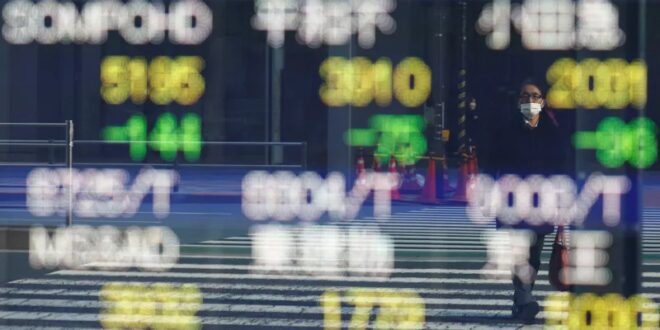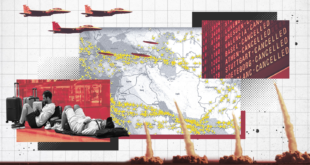Why the Global Economy May Never Be the Same
To say that the last few years have been economically turbulent would be a colossal understatement. Inflation has surged to its highest level in decades, and a combination of geopolitical tensions, supply chain disruptions, and rising interest rates now threatens to plunge the global economy into recession. Yet for the most part, economists and financial analysts have treated these developments as outgrowths of the normal business cycle. From the U.S. Federal Reserve’s initial misjudgment that inflation would be “transitory” to the current consensus that a probable U.S. recession will be “short and shallow,” there has been a strong tendency to see economic challenges as both temporary and quickly reversible.
But rather than one more turn of the economic wheel, the world may be experiencing major structural and secular changes that will outlast the current business cycle. Three new trends in particular hint at such a transformation and are likely to play an important role in shaping economic outcomes over the next few years: the shift from insufficient demand to insufficient supply as a major multi-year drag on growth, the end of boundless liquidity from central banks, and the increasing fragility of financial markets.
These shifts help explain many of the unusual economic developments of the last few years, and they are likely to drive even more uncertainty in the future as shocks grow more frequent and more violent. These changes will affect individuals, companies, and governments—economically, socially, and politically. And until analysts wake up to the probability that these trends will outlast the next business cycle, the economic hardship they cause is likely to significantly outweigh the opportunities they create.
DOWN IS UP
Recessions and bouts of inflation come and go, but the last few years have seen a series of highly unlikely, if not unthinkable, global economic and financial developments. The United States, once a champion of free trade, became the most protectionist advanced economy. The United Kingdom suddenly devolved into something resembling a struggling developing country after an ill-fated mini-budget weakened the currency, pushed bond yields skyward, triggered a “negative watch” designation from ratings agencies, and forced Prime Minister Liz Truss to resign. Borrowing costs increased sharply as interest rates on more than a third of global bonds went negative (creating an abnormal situation in which creditors pay debtors). Russia’s war in Ukraine paralyzed the G-20, accelerating what had previously been a gradual weakening of the institution. And some Western nations have weaponized the international payments system that is the backbone of the global economy in an effort to punish Moscow.
Add to this list of low-probability events China’s rapid recentralization under Xi Jinping and its decoupling from the United States, the strengthening of autocracies around the world, and the polarization and even fragmentation of many liberal democracies. Climate change, demographic shifts, and the gradual migration of economic power from west to east were more foreseeable but have nonetheless complicated the global economic environment.
The inclination of many analysts has been to seek bespoke explanations for each surprising development. But there are important common threads, especially among the economic and financial events, including the failure to generate rapid, inclusive, and sustainable growth; the overreliance of policymakers on a narrow toolkit that over time has created more problems than it has solved; and the absence of common action to address shared global problems. These commonalities, in turn, mostly (although not entirely) boil down to the three transformational changes occurring in the global economy and finance.
WORLD REWIRED
Coming out of the 2007–8 global financial crisis, most economists blamed sluggish economic growth on lack of demand. The U.S. government sought to rectify this problem through stimulus spending (although polarization in Congress constrained this approach from 2011 to 2017) and, more important, through the Fed’s decision to floor interest rates and inject a massive amount of liquidity into the markets. The approach was put on steroids, first by the Trump administration’s spending and tax cuts and then by the emergency support doled out by both the Trump and the Biden administrations to households and companies during the COVID-19 pandemic—all while the Federal Reserve flooded the system with cash.
But unbeknown to many, the global economy was undergoing a major structural change that was making supply rather than demand the real problem. At first, this change was driven by the effects of COVID-19. It is not easy to jump-start a global economy that has been forced to a sudden halt. Shipping containers are in the wrong place, as are the ships themselves. Not all production comes back online in a coordinated manner. Supply chains are disrupted. And thanks to enormous handouts from governments and abundant central bank liquidity, demand surges well ahead of supply.
Already-challenged growth models are coming under even greater stress.
As time passed, however, it became clear that the supply constraints stemmed from more than just the pandemic. Certain segments of the population exited the labor force at unusually high rates, either by choice or necessity, making it harder for companies to find workers. This problem was compounded by disruptions in global labor flows as fewer foreign workers received visas or were willing to migrate. Faced with these and other constraints, companies began to prioritize making their operations more resilient, not just more efficient. Meanwhile, governments intensified their weaponization of trade, investment, and payment sanctions—a response to Russia’s invasion of Ukraine and worsening tensions between the United States and China. Such changes accelerated the post-pandemic rewiring of global supply chains to aim for more “friend shoring” and “near shoring.”
This is not the only rewiring underway. Climate change is finally forcing companies, households, and governments to alter their behavior. Given the dangers facing the planet, there is no choice but to evolve away from destructive practices. The unsustainability of the present path is clear, as is the desirability of a green economy. But the transition will be complicated, not least because the interests of countries and companies are not yet sufficiently aligned on this issue and the necessary international cooperation has been lacking.
The bottom line is that changes in the nature of globalization, widespread labor shortages, and the imperatives of climate change have created supply difficulties and put already-challenged growth models under even more stress.
SCRAMBLING CENTRAL BANKS
Making matters worse, these changes in the global economic landscape come at the same time that central banks are fundamentally altering their approach. For years, central banks in major economies have responded to virtually any sign of economic weakness or market volatility by throwing more money at the problem. After all, by necessity more than by choice, they had been forced to use their admittedly imperfect tools to maintain economic stability until governments could overcome political polarization and step in to do their jobs.
But the longer central banks extended what was meant to be a time-limited intervention—buying bonds for cash and keeping interest rates artificially low—the more collateral damage they caused. Liquidity-charged financial markets decoupled from the real economy, which reaped only limited benefits from these policies. The rich, who own the vast majority of assets, became richer, and markets became conditioned to think of central banks as their best friends, always there to curtail market volatility. Eventually, markets started to react negatively to even hints of a reduction in central bank support, effectively holding central banks hostage and preventing them from ensuring the health of the economy as a whole.
All this changed with the surge in inflation that began in the first half of 2021. Initially misdiagnosing the problem as transitory, the Fed made the mistake of enabling mainly energy and food price hikes to explode into a broad-based cost-of-living phenomenon. Despite mounting evidence that inflation would not go away on its own, the Fed continued to pump liquidity into the economy until March 2022, when it finally began raising interest rates—and only modestly at first.
But by then inflation had surged above seven percent and the Fed had backed itself into a corner. As a result, it was forced to pivot to a series of much steeper rate hikes, including a record four successive increases of 0.75 percentage points between June and November. Markets recognized that that the Fed was scrambling make up for lost time and started worrying that it would keep rates higher for longer than would be good for the economy. The result was financial market volatility that, if sustained, could threaten the functioning of global financial markets and further damage the economy.
RISKY BUSINESS
The conditioning of markets to always expect easy money had another perverse effect, encouraging a significant chunk of global financial activity to migrate from highly regulated banks to less well-understood and regulated entities such as asset managers, private equity funds, and hedge funds. These entities did what they are paid to do: take advantage of prevailing financial conditions to turn a profit. That meant taking on more debt and leverage, venturing further from their areas of expertise, and running ever greater risks on the assumption that easy money and reliable central bank support would persist well into the future.
Few of these firms planned for a sudden change in the cost of borrowing or access to funding. An extreme example of the kind of shock that ensued was the October 2022 near financial meltdown in the United Kingdom. After Truss announced a plan for large unfunded tax cuts, government bond yields surged, catching some of the country’s highly leveraged pension funds by surprise. If it weren’t for an emergency intervention by the Bank of England, a U-turn by the Truss government, and the prime minister’s eventual ouster, the bond selloff could have spiraled into a major financial crisis and ultimately an even more painful recession.
The fragility of the financial system also complicates the job of central banks. Instead of facing their normal dilemma—how to reduce inflation without harming economic growth and employment—the Fed now faces a trilemma: how to reduce inflation, protect growth and jobs, and ensure financial stability. There is no easy way to do all three, especially with inflation so high.
BUMPY ROAD, BETTER DESTINATION
These major structural changes go a long way toward explaining why growth is slowing in most of the world, inflation remains high, financial markets are unstable, and a surging dollar and interest rates have caused headaches in so many countries. Unfortunately, these changes also mean that global economic and financial outcomes are becoming harder to predict with a high degree of confidence. Instead of planning for one likely outcome—a baseline—companies and governments now have to plan for many possible outcomes. And some of these outcomes are likely to have a cascading effect, so that one bad event has a high probability of being followed by another. In such a world, good decision-making is difficult and mistakes are easily made.
Fortunately, what it takes to navigate such a world is not a secret. Resilience, optionality, and agility are all vital. Resilience, or the ability to bounce back from setbacks, is often dependent on strong balance sheets and stamina, endurance, and integrity. Optionality, which enables a change in course at a low cost, is underpinned by the open-mindedness that comes from diversity in gender, race, culture, or experience. And agility, or the ability to react quickly to changing conditions, depends on leadership and governance that allow for bold moves in moments of greater clarity.
This trifecta of resilience, optionality, and agility will not insulate companies and households from all the economic and financial bumps that lie ahead. But it will significantly enhance their ability to navigate those bumps and increase the probability that they will wind up at a better destination—one that is more inclusive, climate-friendly, and collaborative and a lot less reliant on a distorted and precarious finance.
For national governments and central banks, the goal should be to minimize accidents along this journey and improve the odds that everyone winds up in a better place. Policy priorities should include modernizing infrastructure to help increase supply, improving labor training and retooling programs, and launching public-private partnerships to meet pressing needs such as vaccine development. At the same time, governments and central banks should keep fighting inflation and improve the coordination of fiscal policy, monetary policy, and structural reforms that enhance productivity and growth.
Economic and financial outcomes are becoming harder to predict.
Governments should also improve supervision and regulation of non-bank financial entities, which will require gaining a much better understanding of the technical linkages between them, the implicit leverage that lurks off their balance sheets, and the channels through which risk can spread to the broader financial system. Finally, governments should put in place stronger safety nets to protect the most vulnerable segments of society, which time and again have been the most exposed to economic and financial shocks.
Such efforts will need to extend to the multilateral level. Governments will need to work together to reform international financial institutions, pool insurance against common shocks, enhance early warning systems, preemptively restructure the debts of countries laboring under heavy debt overhangs that starve their social sectors and inhibit capacity building, and improve the functioning of the G-20.
This is a tall order, but a feasible one. The longer households, companies, and governments fail to recognize and respond to the structural shifts taking place in the global economic and financial system, the harder it will be to mitigate the risks and to seize the opportunities associated with these changes. The world isn’t just teetering on the brink of another recession. It is in the midst of a profound economic and financial shift. Recognizing this shift and learning to navigate it will be essential if the world is to arrive at a better destination.
 Eurasia Press & News
Eurasia Press & News



